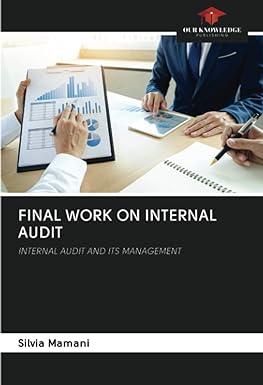Question
An analyst obtains an OOS result for the release assay of a parenteral product; she decides that she has made a mistake and, therefore, proceed
An analyst obtains an OOS result for the release assay of a parenteral product; she decides that she has made a mistake and, therefore, proceed to a retest, which also turns out to be an OOS. The lab SOP indicates that an initial investigation should have been done before any retesting was done. How should we treat the results?
- The retest results are invalid since the analyst did not follow the SOP
- All results should be included in the initial lab investigation
- The product should be rejected since the analyst confirmed the OOS result
- Since the analyst did not follow the SOP, we conclude that the analyst made a mistake and needed retraining; therefore, all results are invalid.
- All of the above
-
B2. Which of the following is an example of raw data?
- Signed Final Report for the study
- Printouts of Excel worksheets used to calculate final results
- Temperature log of lab refrigerators
- Certificate of Analysis of a released batch of product
- a and c only.
B3. What is the typical acceptable length for an investigation of a discrepancy:
- 24 hours
- 1 week
- 3 months
- 1 month
- 6 months
- 1 year
B4. The following are common observations on OOS investigations:
- Ignoring failing results
- Selected data reporting
- Not following safety procedure
- Storing food in the lab
- a and b only
- a and d only
B5. When you qualify a chamber, which of these qualifications that you do with a distribution study in the chamber?
- Design Qualification
- Installation Qualification
- Operation Qualification
- Performance Qualification
- All of the above
B6. If you have an OOS on stability samples, what other data you should consider?
- Data of other packaging configuration for the same batch
- Data of the batch record
- Data of other time points of the stability study
- Data from similar packages of different products
- A and C only
- All of the above
B7. How do you prevent an OOS result?
- Anticipate and prevent a failure of the equipment
- Average the results to fall into the specification
- Continue the test to the end if you suspect an OOS result and repeat it
- Change the method even though it wasnt approved to list a new specification range
- All of the above
B8. The equipment (metrology) program includes:
- calibration of instruments
- approval of API methods and specifications
- development of calibration procedures and specifications for each instrument
- all of the above
- a & c only
B9. The OOS Investigation guideline does not apply to the following:
- Dissolution testing
- Process analytical technology testing
- In-Process testing
- Elemental Impurities testing
- Moisture testing
B10. The following action is not part of the analysts responsibilities in an OOS investigation:
- Review the experiment details
- Review the instrument details
- Review the batch record details
- Review the stability data
- None of the above
Step by Step Solution
There are 3 Steps involved in it
Step: 1

Get Instant Access to Expert-Tailored Solutions
See step-by-step solutions with expert insights and AI powered tools for academic success
Step: 2

Step: 3

Ace Your Homework with AI
Get the answers you need in no time with our AI-driven, step-by-step assistance
Get Started


